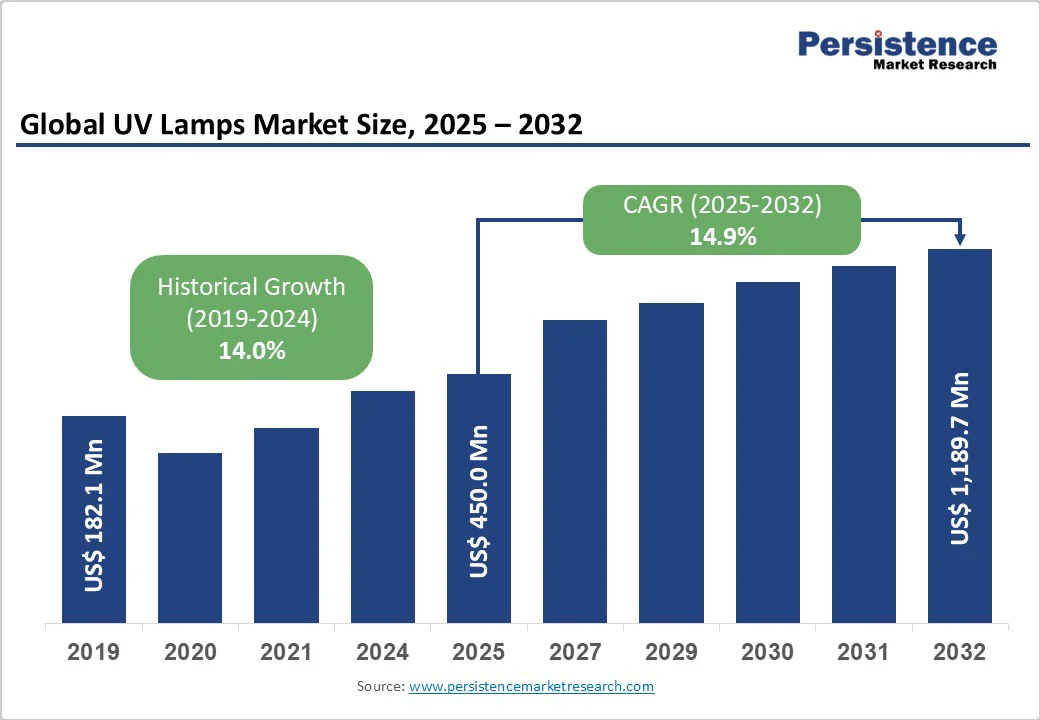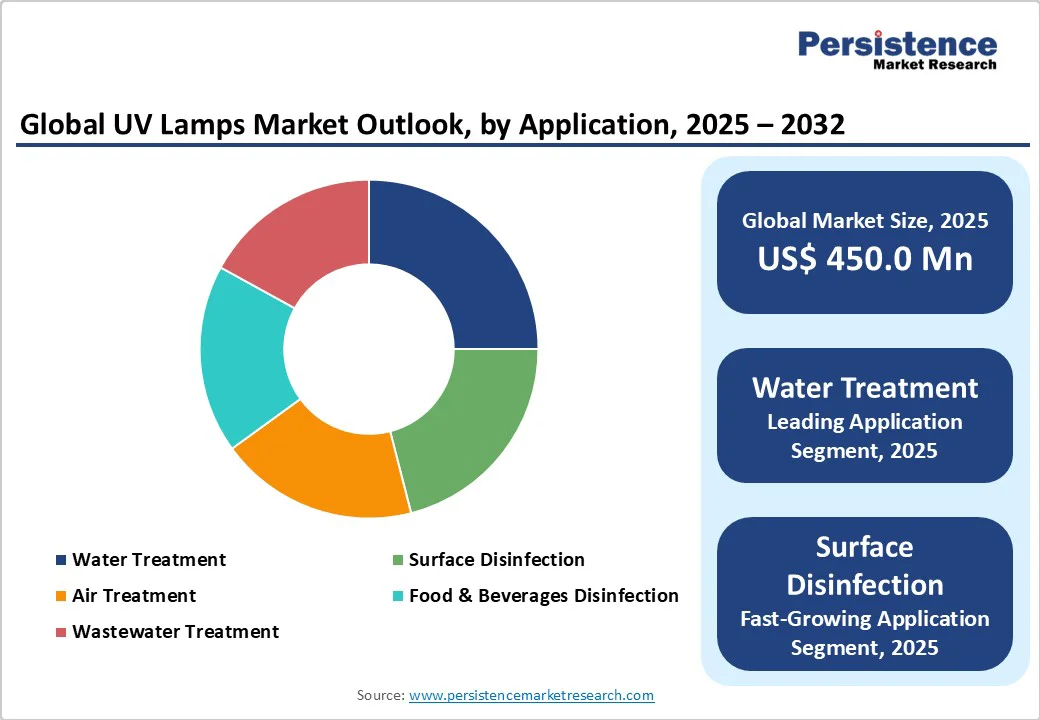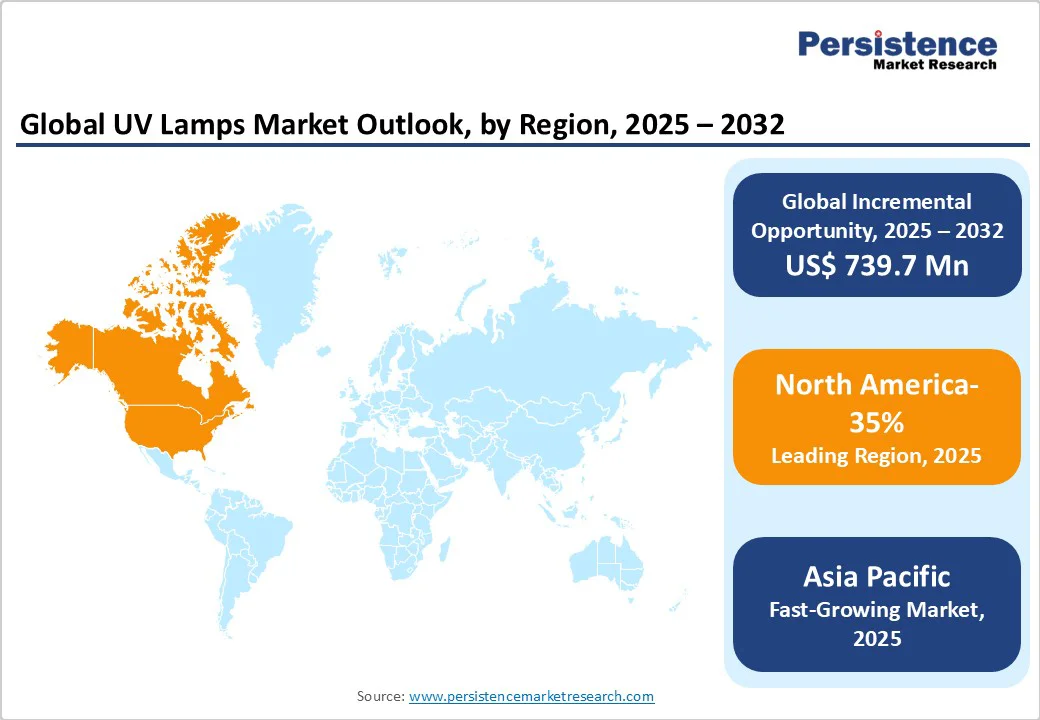ID: PMRREP30025| 173 Pages | 10 Oct 2025 | Format: PDF, Excel, PPT* | Semiconductor Electronics

The global UV lamps market size is likely to be valued at US$450.0 Million in 2025 and is expected to reach US$1,189.7 Million by 2032, growing at a CAGR of 14.9% during the forecast period from 2025 to 2032.
Increasing demand for chemical-free disinfection in healthcare, water treatment, and public infrastructure is a key growth driver. Enhanced hygiene awareness, regulatory support, and advancements in UV-C and LED technologies are boosting adoption.
| Key Insights | Details |
|---|---|
| UV Lamps Market Size (2025E) | US$450.0 Mn |
| Market Value Forecast (2032F) | US$1,189.7 Mn |
| Projected Growth (CAGR 2025 to 2032) | 14.9% |
| Historical Market Growth (CAGR 2019 to 2024) | 14.0% |

Stringent environmental regulations are a major factor driving the UV lamps market, as authorities push for safer technologies with lower environmental impact. For instance, the U.S. Environmental Protection Agency (EPA) requires UV disinfection devices that claim to kill viruses or bacteria to comply with the Federal Insecticide, Fungicide, and Rodenticide Act (FIFRA).
This ensures manufacturers design lamps that meet strict safety standards, reduce hazardous substances such as mercury, and improve energy efficiency. Such measures are encouraging the development of eco-friendly UV technologies and accelerating their adoption across industries.
At the same time, rising health awareness is boosting demand for UV lamps in healthcare, water treatment, and public infrastructure. Growing concerns about indoor air quality, clean water, and effective sterilization-intensified after the COVID-19 pandemic-have strengthened the use of UV disinfection as a chemical-free method. Together, regulatory enforcement and health-conscious practices are significantly propelling the industry worldwide.
High initial costs remain a significant restraint for the UV lamps market. The manufacturing of UV lamps, particularly advanced UV-C and UV LED systems, involves complex processes and specialized materials that drive up prices.
Additionally, installation and integration costs for large-scale applications in healthcare, water treatment, and industrial facilities often deter smaller organizations from adopting the technology. This upfront expenditure limits broader market penetration, especially in developing regions where budget constraints are higher.
Another challenge is the limited penetration of UV LEDs compared to traditional mercury-based UV lamps. While UV LEDs offer advantages such as compact design, low energy use, and longer lifespan, they currently face performance limitations in terms of intensity and wavelength stability. This technological gap slows widespread adoption and restrains overall market growth.
Advancements in UV LED technology are creating strong growth opportunities for the UV lamps market. Continuous improvements in efficiency, wavelength precision, and durability are expanding their applicability across disinfection, medical, and industrial uses.
Unlike traditional mercury-based lamps, UV LEDs are compact, energy-efficient, and environmentally friendly, aligning with global sustainability goals. Ongoing R&D is also helping overcome challenges related to output power and wavelength stability, making UV LEDs a preferred choice for next-generation applications.
Emerging markets further enhance this opportunity, as growing urbanization and infrastructure development increase demand for effective water and air treatment solutions. Countries in the Asia Pacific, Latin America, and the Middle East are investing in healthcare, sanitation, and clean energy, where UV LED adoption can provide cost-effective, scalable, and eco-friendly disinfection technologies.
In 2025, UV mercury lamps continue to dominate with 55% market share, largely due to their established use in water treatment, air purification, and industrial processes. Their proven effectiveness, high intensity, and relatively lower cost compared to emerging technologies make them the preferred choice for large-scale disinfection systems. Industries and municipal facilities still rely heavily on these lamps, given their ability to deliver consistent performance across a wide range of applications.
UV LEDs are emerging as the fastest-growing segment, driven by their eco-friendly design, compact size, and energy efficiency. With growing restrictions on mercury-based products and advancements in LED efficiency, UV LEDs are quickly gaining traction. Their longer lifespan, low maintenance, and adaptability across healthcare, residential, and consumer electronics sectors position them as the next-generation technology fueling market growth.
In 2025, water treatment applications dominate the UV lamps market with a 25% share, as governments and industries prioritize clean water access and stringent hygiene standards. UV lamps are widely deployed in municipal treatment plants, industrial facilities, and residential systems due to their chemical-free disinfection capability and effectiveness against bacteria, viruses, and protozoa. Rising global concerns over waterborne diseases and the need for sustainable treatment methods continue to support this strong market position.
Surface disinfection is emerging as the fastest-growing segment, propelled by heightened awareness of hygiene in healthcare, food processing, and public infrastructure. The COVID-19 pandemic accelerated demand for effective sterilization solutions, and UV lamps offer rapid, contactless disinfection. Increasing adoption in hospitals, transport hubs, and commercial spaces positions this segment for robust growth in the coming years.

North America dominates the UV lamps market in 2025 with a 35% share, driven by stringent regulatory frameworks, advanced healthcare infrastructure, and widespread adoption of disinfection technologies. The region benefits from strong enforcement of environmental and health safety standards, particularly in water and wastewater treatment, where UV lamps are extensively used.
Growing investments in healthcare facilities, rising demand for indoor air quality solutions, and heightened awareness of infection control post-COVID-19 further strengthen market growth. Additionally, the presence of leading manufacturers and ongoing technological innovations in UV LEDs contributes to North America’s leading position.
Europe holds a significant share of the UV lamps market, supported by strict environmental regulations and a strong emphasis on sustainable technologies. The region has been at the forefront of restricting mercury-based products under initiatives such as the EU RoHS Directive, which encourages the shift toward eco-friendly UV solutions.
High adoption rates in water and wastewater treatment plants, combined with growing demand for surface and air disinfection in healthcare and food processing industries, reinforce Europe’s market strength. Moreover, increasing R&D investments and supportive government policies promoting green technologies continue to drive the adoption of advanced UV lamps across the region.
Asia Pacific represents the fastest-growing region in the UV lamps market, driven by rapid urbanization, expanding industrial activities, and increasing investments in water and air treatment solutions. Rising populations in countries such as China and India are amplifying the need for clean drinking water and enhanced sanitation, boosting the deployment of UV lamps in both municipal and residential sectors.
The region is also witnessing accelerated adoption in healthcare facilities and laboratories, supported by stricter hygiene standards and heightened focus on infection prevention. Moreover, government initiatives promoting sustainable water management and the strong presence of cost-effective manufacturers are fueling market expansion.

The global UV lamps market is characterized by continuous innovation, strategic collaborations, and a focus on sustainable technologies. Companies are investing heavily in research and development to enhance efficiency, extend product lifespan, and reduce environmental impact.
Many are shifting toward mercury-free UV LEDs to align with global regulations and sustainability goals. Additionally, mergers, acquisitions, and regional expansions are strengthening market presence, while increasing demand across healthcare, water treatment, and surface disinfection continues to drive competition.
The UV lamps market is projected to reach US$450.0 mn in 2025, driven by water treatment and health safety demands.
Stringent environmental regulations, health awareness, and UV LED advancements fuel market growth.
The UV lamps market will grow from US$450.0 mn in 2025 to US$1,189.7 mn by 2032, with a CAGR of 14.9%.
UV LED innovations and emerging market sanitation projects drive opportunities in water and air purification.
Leading players include Xylem Inc., Calgon Carbon, Trojan Technologies, Xenex, OSRAM, Philips, Severn Trent, Heraeus, Halma, and Atlantic Ultraviolet.
| Report Attribute | Details |
|---|---|
| Historical Data/Actuals | 2019 - 2024 |
| Forecast Period | 2025 - 2032 |
| Market Analysis | Value: US$ Mn, Volume: As Applicable |
| Geographical Coverage |
|
| Segmental Coverage |
|
| Competitive Analysis |
|
| Report Highlights |
|
By Lamp Type
By Application
By Region
Delivery Timelines
For more information on this report and its delivery timelines please get in touch with our sales team.
About Author